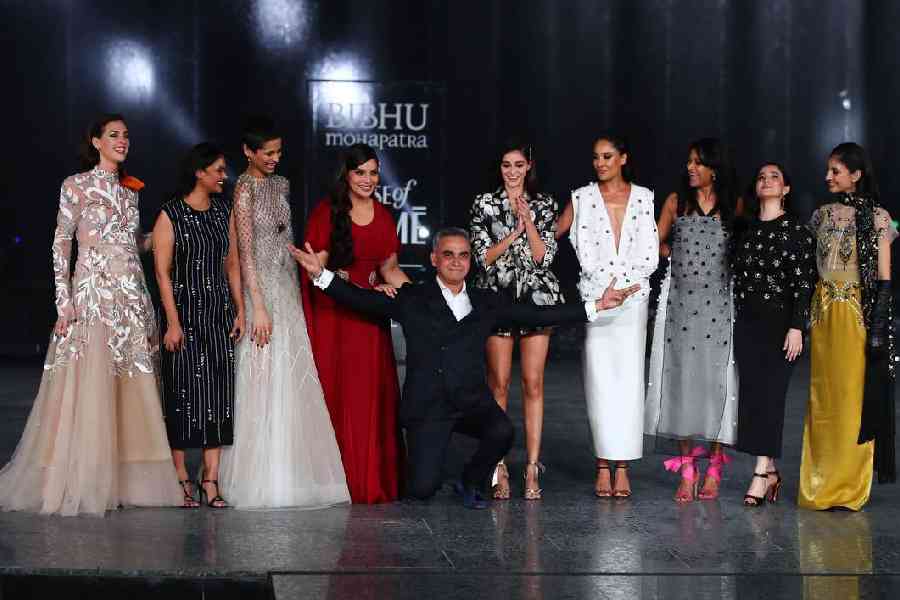In his black T-shirt and trousers, Bibhu Mohapatra was the most unassuming when he walked in at The Imperial in Delhi, for an exclusive chat with t2 on the morning of his grand finale showcase at the Lakme Fashion Week in partnership with FDCI at Pragati Maidan in Delhi earlier this month. Like he always is. Despite the global fame. Despite a Michelle Obama or a Jennifer Lopez on his CV. He spoke with candour that was at once fearless and earnest, wrung with the heartfelt. Much like his showcase ‘Come Home’ that played out later that evening at a packed venue near H14, with towering fountains as the backdrop. The models walked to pulsating live music in functional, feminine, powerful, soft yet statement, glamorous and bold silhouettes. Dynamic and striking, Bibhu’s women were never to be taken for granted — fiercely elegant, playful and mysterious but always imbued with a sense of the self.
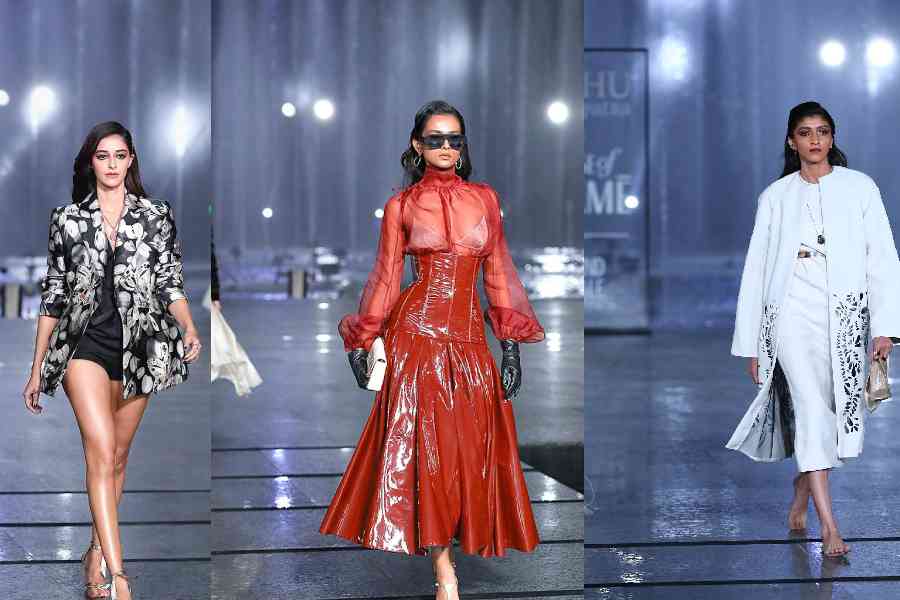
(l-r) Ananya Panday rocked an embroidered Blossom Double Breasted Blazer that was teamed with an Onyx Sculpted Satin Blouse and cropped shorts. So chic. We loved the florals. The Red Stone patent leather full skirt paired with a silk organza blouse was absolute boss lady. The model walked barefeet, heels in hands, in her Porcelain Precision-Cut Coat with Porcelain Cady Molded Sheath Dress
In a leisurely chat, the Rourkela-born designer decoded the collection and chatted about the need for compassion. Excerpts.
Let’s start with what you are showing tonight...
It’s the latest collection, which is my spring-summer ‘24 (line), but it’s a curation of 77 looks. We also have the iconic pieces from the entire life of the brand, which is 14 years. So, we have taken the greatest moments, just to draw a parallel between the collection and the Lakme muses who are legendary faces.
What do these muses mean to you?
They are leaders and pioneers and have paved the way for many and theirs have been the iconic faces of Lakme and they are stars in their own right. In some cases, I have met them and in some cases, I have not, but I am very aware of their work, in what they represent. We are celebrating what they have done, but also celebrating who they are today and why it is important to recognise that. The entire endeavour is to make sure that it is a homage to Indian women, in the modern Indian landscape. Indian women play a dynamic role in their families, their professional world and in different fields. In some cases they are recognised and in some cases they stay under the radar and it’s those everyday muses that I am paying homage to.
Augusta Savage and Simone Leigh inspired your Spring ’24 collection. Why did they speak to you?
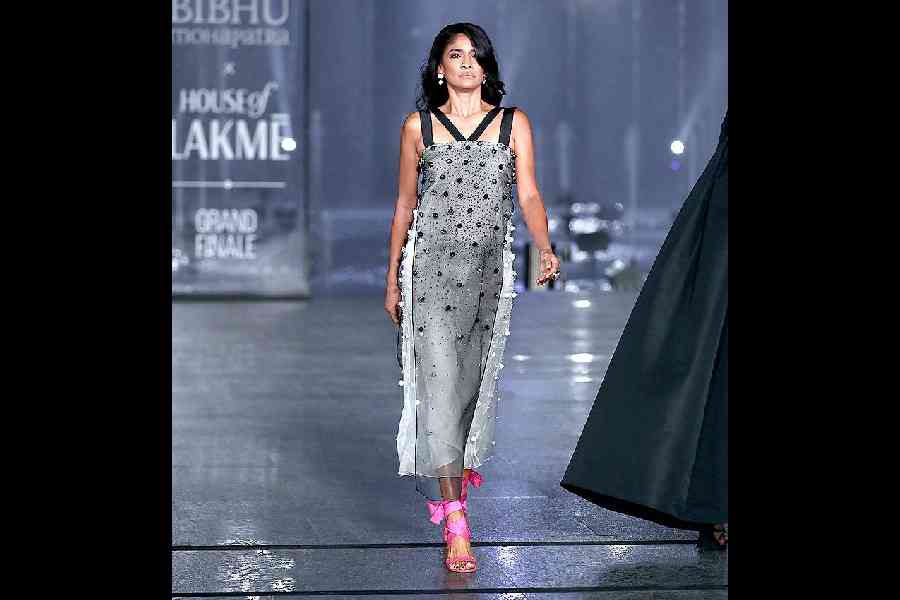
There was a celebratory feel about this Onyx and Porcelain Silk Organza Dress with sequinned pearl embroidery
They spoke to me. Many years ago I found a story on Augusta Savage. She was one of the pioneers of the Harlem Renaissance movement from the ‘30s. It was a cultural and artistic movement that gave rise to an era.... In that time frame, at a time when if you were a person of colour, you were always marginalised and if you were a woman and a person of colour, then you were doubly marginalised. She was a pioneer. She was a female sculptor who was recognised outside of America and went to France to get trained, but in America, because of her skin colour and gender, she was not given the lift. In 1939, in the World’s Fair (New York World’s Fair), she was commissioned to do a piece. That piece unfortunately no longer exists because she didn’t have the resources to cast it in bronze. It’s expensive to be an artist.... The story that inspired me was she always went against the grain and she made the most of her time and work and situation. She became a hero against all the injustices. She left it all and went off to Sydney, opened a school and started training young artists, some of whom later became the major creative forces. She said her legacy would be the works of the people she was training.
I then drew a parallel between the ’30s and the current now with Simone Leigh. She has represented the US at the Venice Biennale. She holds Augusta as a hero. It’s really mapping what progress did America make and how difficult and easy it is for a female artist and a person of colour to express themselves and make a mark. Traditionally, in the art world, all the famous sculptors and painters are all white men, mostly... I am just giving my voice to highlight these people who have stood against that barrier and still made their mark.
You have lived in New York for decades now. What is the situation for coloured people now?
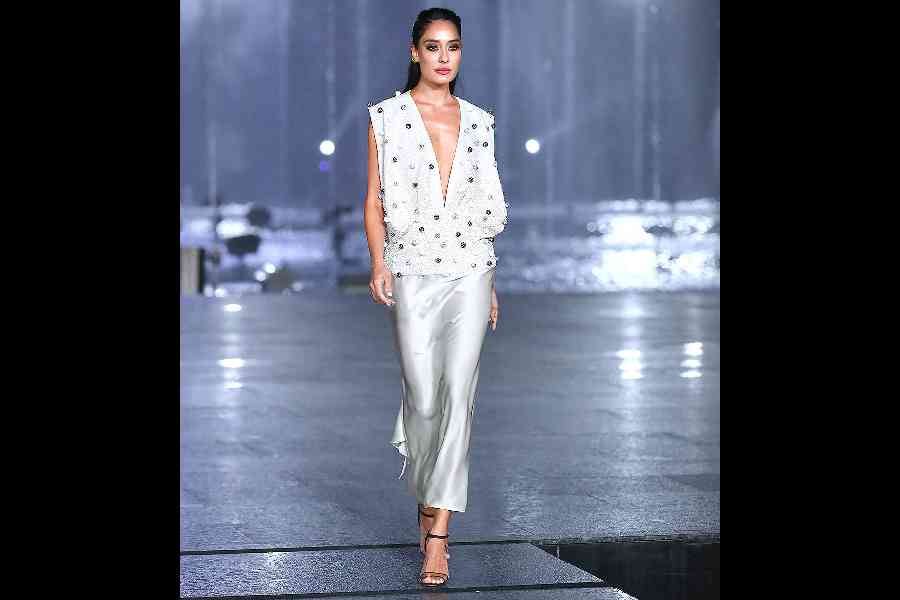
Lisa Haydon was smoking hot in this Porcelain Sculpted Cady and Silk Charmeuse Dress with sequinned pearl embroidery
I think New York is a bubble, or California.... There is a lot more exposure and a lot of immigrants came there and their bases are there. I am talking about 1700-1800s. But if you are in middle America, people will look at you twice. New York is interesting because of its diversity and how it’s a refuge for people who are trying to make it. But in America in general, sure, there is still discrimination.
How did you personally react to it initially vs now?
Initially, I didn’t even realise it and someone had to point it out. I realised they tried to talk to you slowly and loudly to make sure you understood English. They don’t know that everyone speaks in English and studies in English here. Then I realised that’s someone putting you in a box because of the way you looked. I am more clever about it now as to how to react to it or not at all or making it clear that it is not cool. I have confronted people when I have seen someone being discriminated against. It is just the wrong thing to happen in front of me. At that point I become very fearless.
How have you grown as a person with the decades of your label?
I have learnt a lot and I am still learning. I have learnt a lot from my mistakes than the high notes. I always say that I keep my failures closer to my heart. Those are my guardrails. I mentor students every year. I share what I have learnt every time I have fallen down. My worst experiences are my biggest treasures.
How do you look back at the journey, easy or difficult?
It’s very inspiring. I look forward to waking up every morning and going to my atelier. We opened our first flagship store in New York. I am the first one to open it (every day) and I have two hours to do my own thing, clear my head, fix the store. I think I have evolved and learnt how to pivot and change course. We all hopefully learnt a lot during Covid. I think I am a much more mature person in that regard. Come what may, if the focus is on the right thing, the production of the right product, the integrity of the product, then everything else is fine. The key is not to get deterred. We have to move on.
Now when you come back to India, how do you think India has changed?
It has changed big time. I like the fact that the younger generation is super exposed and super savvy, educated and hopefully a lot more hypersensitive about social issues and standing up for each other, even if it is someone from a different community. If I am LGBTQ, I have all my interests shifted to someone who is being discriminated against because of their gender, but in addition to that I need to be sensitive (about others too).
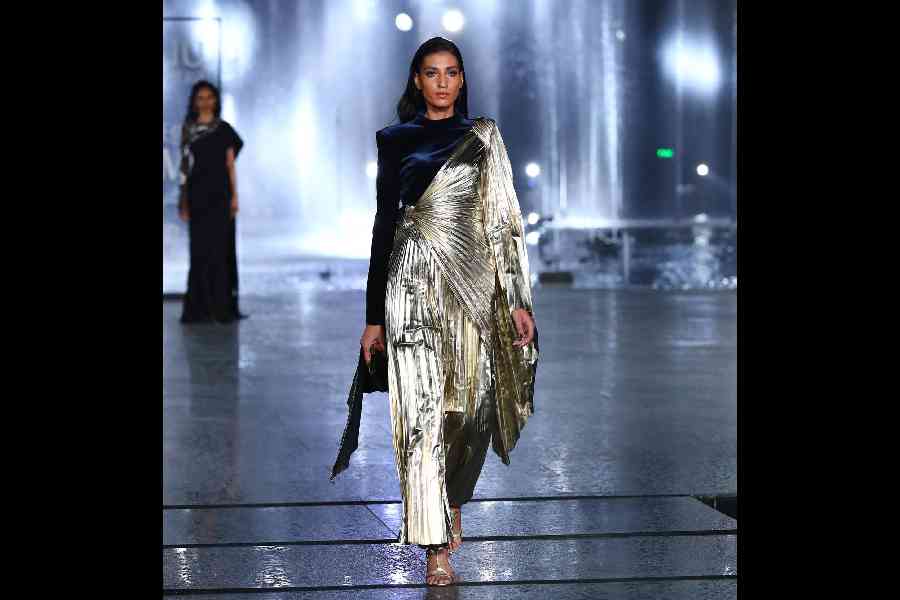
The play of metallics and velvets made for one power-packed look
When President (Barack) Obama left, I was at the party at The White House and was introduced to him. I asked him how we go from here to what’s coming, the four years of Donald Trump. He said something very clever... he said, it’s not going to be easy and the easiest way for all of us is to be sensitive about each other’s issues. We can’t just be focused on ourselves. If something is happening to them, it is only a matter of time before it happens to you. That stayed with me. It is important to be compassionate about the problems of others.
There is a new promise and excitement with the development. The middle class has risen and there is a lot of aspiration. But I do feel we need to pay attention to the agricultural community because a major portion of India’s economy is agriculture. How do we make sure that we bring them along? Progress happens but there’s always someone who is left behind. It happens in America also, but efforts have to be made to bring as many as we can with us.
Since you are celebrating women today, what about women amazes you?
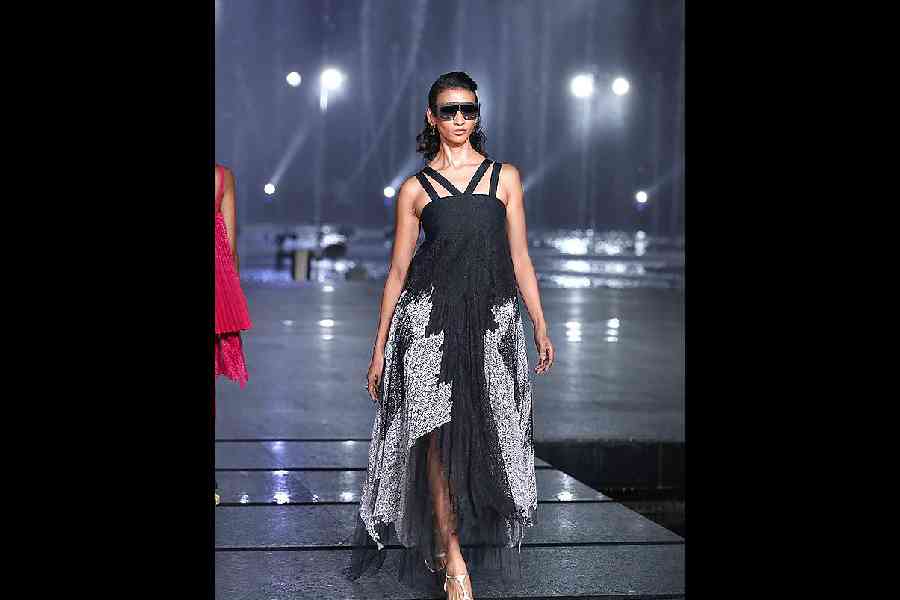
There was a sense of effortless wow in this onyx Locust Leaf Applique dress
I think without women, none of us would be here. In our cultures, mothers give us a lot in how we are shaped. My mother taught me how to sew. A traditional mother from Odisha teaches her son how to sew. That was it and I never stopped. I kept making things and she always guided me through that. My sister was my first muse and I would make horrible things.... Then I got better and my mother commissioned me a piece for her for a family wedding. I made an outfit in yellow, gold and black and my sister walked in and everyone’s heads turned. She was 14-15 I think. My sister is very shy but she walked with such confidence... the chiffon was flowing and she was wearing a cotton jacket. She felt like herself and confident. That stayed with me. Clothes made well can really empower people.
(The women in my family) are always present and always guiding me. So, this collection is to them and the younger generation, to my two nieces.
How has your feminine side helped you in your creative journey?
Immensely. Visualising how it’s going to be and that refined way of imagining what it means to be stylish in a sari, I think I had the understanding of it. I remember my mother asking me what she should pair her sari with. I tapped into my feminine side and I still do. Without that I won’t be able to create.
